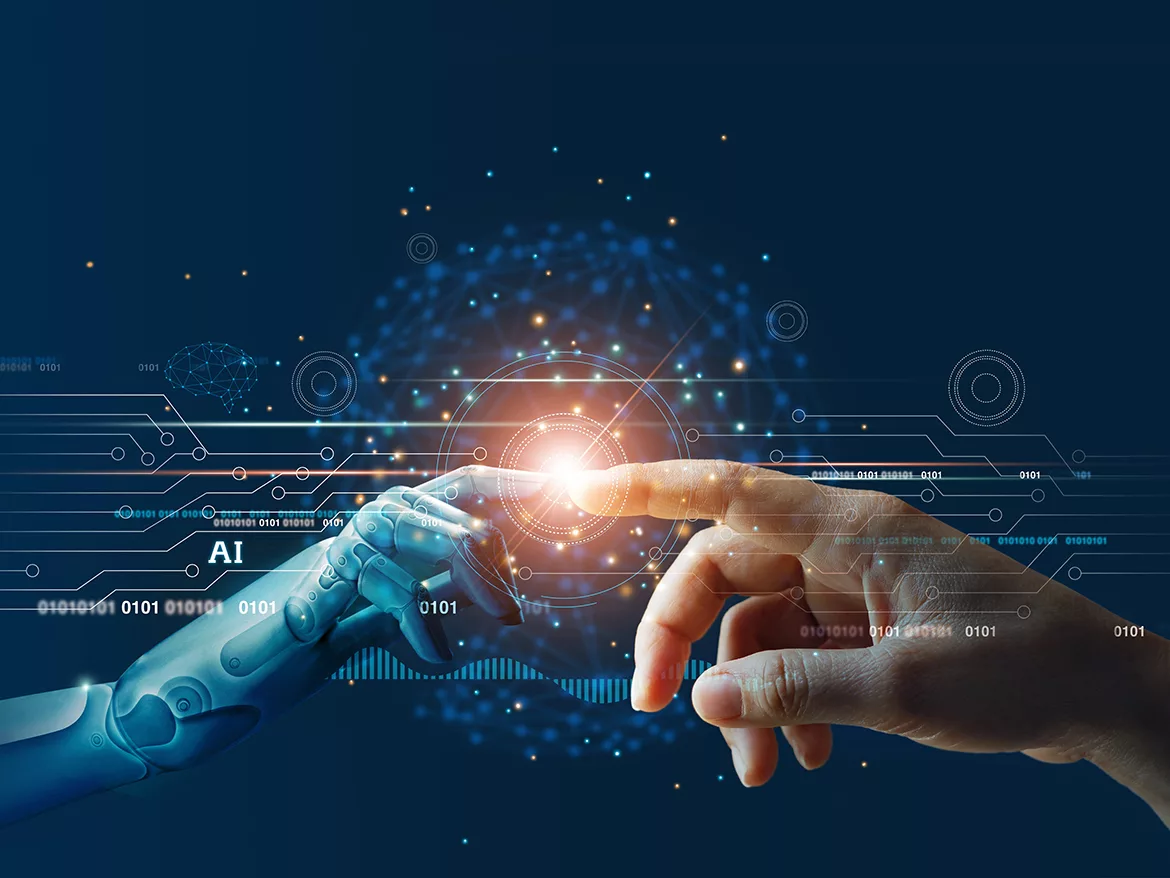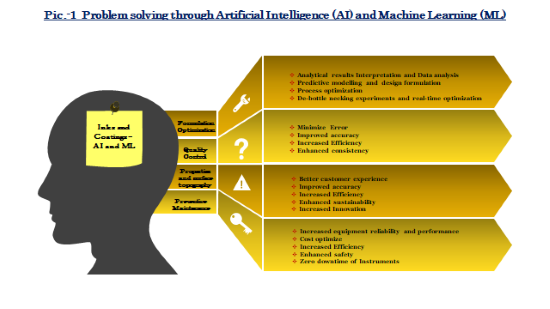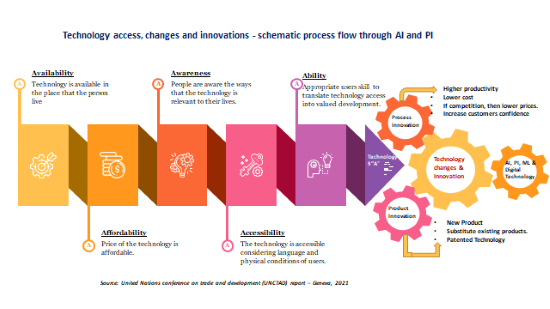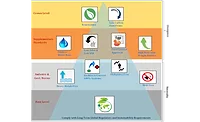Digital Technologies to Accelerate Development and Innovation in Coatings

Image credit: ipopba, iStock, via Getty Images.
The traditional approach of R&D is time consuming and expensive; a systematic experimental program that tests variations in the formulation, identifying those that produce the best results. Data from past experiments is used to design these programs, identifying relationships between properties and formulation features to suggest what changes should be tried. But the available data is usually sparse.1-4
Coatings and ink properties like color, rheological behavior, adherence to surfaces, and response to light depend on subtle changes in the nature, proportions, and processing of ingredients. The challenge of understanding these subtleties is similar for other formulated products and plastics. Manufacturers want to control properties, not only to make new products, but also to re-formulate in response to market pressures. For example, replacing an ingredient that has become expensive or that is subject to new environmental regulations.
Factors like the toxicity of the inks, adhesives, and coatings, price fluctuations based on market demand, environmental impact, alternative materials, etc., can also be determined using artificial intelligence (AI) and machine learning (ML) technologies. In fact, computer vision and AI are used to analyze images in bulk to develop smart coatings. By understanding the functioning of the microstructures in the materials, a manufacturer can not only create more durable and better-quality inks, but can also optimize production to reduce input costs.
Artificial Intelligence
AI technology is a theory based on computer technology, with data as the core, featuring expert systems, and applying knowledge from mathematics and physics. Artificial intelligence is a multi-disciplinary and marginal discipline, which consists of five main processes: perception, understanding, reasoning, learning, and adaptation.2 The core idea of artificial intelligence is to simulate human intelligence, and its development is closely related to factors such as computer hardware, software systems, and learning algorithms. With the continuous development of electronic information technology, artificial intelligence technology will also be continuously improved and enhanced, and its application scope will be further expanded. The application of artificial intelligence in coatings, printing ink and adhesive research technologies monitoring mainly includes data analysis and processing, pattern recognition, and classification.
How Does AI Work?
Across the globe, AI has accelerated. Vendors have been scrambling to promote how their products and services use it. They refer to AI as simply a component of the technology, such as machine learning and digital technology. AI requires a foundation of specialized hardware and software for writing and training machine learning algorithms. No single programming language is synonymous with AI, but Python, R, Java, C++, and Julia have features popular with AI developers.
In general, AI systems work by ingesting large amounts of labelled training data, analyzing the data for correlations and patterns, and using these patterns to make predictions about future outcome. In this way, a chatbot (Chat GPT) that is fed examples of text can learn to generate life-like exchanges with people, or tools can learn to identify and describe objects in images by reviewing millions of examples (Figure 1).
FIGURE 1| Problem solving through AI and ML.

AI vs. ML vs. PI: Similarities and Differences
Similarities
Predictive Intelligence (PI) uses ML and AI as tools to collect data and predict possible outcomes. ML and PI are both sub-areas within the broader category of AI, and utilize it in their operations.
Differences
- Artificial Intelligence vs. Machine Learning: AI and ML have a lot of overlap since ML is a subset of AI. However, there are some key differences, beyond just the fact that AI is a broader term than ML. For example, the goal of AI is to create computer systems that can imitate the human brain. The goal is to create intelligence that is artificial, hence the name. On the other hand, ML is more focused on training machines to perform certain tasks and learn while doing that. AI tends to focus on solving broad and complex problems, whereas ML focuses on streamlining a certain task to maximize performance.
- Artificial Intelligence vs Predictive Intelligence: The most glaring difference between AI and PI is that AI can be autonomous and learn on its own. On the other hand, PI often relies on human interaction to help query data, identify trends, and test assumptions.
- Machine Learning vs Predictive Intelligence: Much like AI, a big difference between ML and PI is that ML can be autonomous. It’s also worth noting that ML has much broader applications than just PI. It has applications such as error detection and reporting, pattern recognition, etc. Additionally, PI can utilize ML to achieve its goal of predicting data, but that’s not the only technique it uses.
AI and PI Technologies Change Innovation Concept
AI and PI combined with digital technology can transform production and business processes. One of the most critical aspects is access, which can be considered to comprise a combination of ‘5 As’: availability, affordability, awareness, accessibility, and ability for effective use in R&D and production (Figure 2).
FIGURE 2|Technology access, changes, and innovations – schematic process flow through AI and PI.

Challenges Faced in Coatings, Ink, and Adhesive Industries
- Optimization of the composition of the multi-component resin of coatings, inks, and adhesive systems because their properties depend on the system’s composition.
- Because the properties depend upon the chemical structure and composition of the system, the prediction of the physical properties like viscosity, adhesiveness, and surface phenomenon are challenges.
- Due to the chemical complexity, the coarse graining of inks, resins, coatings, and adhesives is difficult.
- Monitoring and controlling the curing process is crucial for achieving the required material properties.
- Due to the use of hazardous chemicals and energy-intensive processes, these technologies have environmental implications.
How AI Can Overcome These Challenges
- Align business vision with goals. Understand current business position and long-term goals.
- Create a strategy to integrate AI and ML tools with the existing systems. Make sure the inputs from employees across the enterprise are considered.
- Prioritize requirements and budget to choose between developing an AI model from scratch and customizing an existing model.
- Set up integrations in all departments to create a centralized database. The AI model will create unique dashboards for real-time analytics.
- Train employees to use the data and analytics for day-to-day decision making. From R&D to factory production to sales and customer service, artificial intelligence is useful at all levels in an ink, coatings, and adhesive company.
Co-Existed R&D Transforms Product Development Through New Tools
Whether working in a polymer synthesis, ink formulation, or paint and coatings lab, the practical data workflows and statistical platforms surrounding formulation development are all quite similar. Pre-formulation testing, the first stage of the process, involves the analysis of the physical and chemical properties of the ingredients for analytical methods development, including the evaluation and QC testing of raw materials. The second stage of the process, formulation, requires extensively testing the combinations of a wide variety of ingredients to achieve the desired characteristics of the final product.
This multi-layered process will typically involve testing two to 25 substances/raw materials that may go into a product, with as many as 30 different parameters being measured for the product itself. Almost 90% of the materials science and chemical companies are using Excel and laboratory notebooks to manage these processes, creating data silos that prevent digitization, automation, and the aggregation of data required for predictive formulation data modelling and leveraging cross-project learnings.
The complexities of a data centralization strategy are common across both the materials science and chemical industries, where ‘out of the box’ and ‘assembled’ systems do not provide scientists and formulators viable solutions to how their data is presented and shared amongst the teams. From raw material lot tracing to compound mixing and final product performance, there is a lot of information to capture effectively.
Scientists can use the platform to store, visualize, and analyze critical experiment data from raw ingredients and different suppliers to experimental results. Advanced machine learning (ML), predictive intelligence (PI), or artificial intelligence (AI) models that are layered into this unique platform allows scientists to predict how new formulations perform, and uncover new relationships that they might not have recognized because the analysis is streamlined and surfaces in an intuitive way (Figure 3).
FIGURE 3| Schematic showing interaction between various physical and chemical phenomena in polyurethane development an applications.

Conclusion
Artificial intelligence, machine learning, and digital technology will continue to play a vital role in the inks, adhesives, and coatings industries for a long time. With industry gaining popularity, manufacturers have to adopt digital transformation and invest in AI tools, internet devices, digitalization etc., to survive market competition. Digitalization has the potential to drastically transform the coatings industry, allowing for better knowledge management, accelerated innovation, and improved data security while reducing product launch time to market. However, an ill-conceived digital transformation strategy can result in wasted resources and increased risk. Digital transformation through AI, ML, and PI strives to bring innovative coating solutions in a sustainable, responsible, and accessible way.
Formulation development is of critical importance in the research and development (R&D) lifecycle of a product. However, many organizations are struggling to manage the complexity of data arising from the modern formulation process. Advanced analytics powered by AI, ML, and PI hold the potential to predict new formulation performance, provide optimized experimental recommendations, and accelerate innovation. Without an effective data-centric digitization strategy in place, these transformative tools remain just out of reach. The processing and analysis of a large amount of different experimental data of formulations and the chemistry of raw materials behaves in formulation, necessitate numerous operations to acquire additional information, which can impose a significant burden on this industry and inspection system. Also, artificial intelligence algorithms, predictive intelligence, and machine data require a significant amount of time to compute and process vast amounts of data. Disadvantages of AI is that it could eliminate human jobs, increasing unemployment rates; there is a limited supply of qualified workers to build AI tools; and it is expensive.
References
1 Li, X.; Liu, D.; Pu, Y.; Zhong, Y. Recent Advance of Intelligent Packaging Aided by Artificial Intelligence for Monitoring Food Freshness. Foods, 2023, 12(15), 2976.
2 Zhu, J.; Ren, C. Analysis of the Effect of Artificial Intelligence on Role Cognition in the Education System. Occup. Ther. Int. 2022, 2022, 1781662.
3 United Nations conference on trade and development (UNCTAD) report – Geneva, 2021.
4 Gillis, P., Quan, Y., Chi-Wei, T, Khan, I., Shafi, A., Ginzburg, V., and Claracq, J., Fundamental Polyurethanes Foam Flow Simulations using Bubble Nucleation and Growth Models. Polyurethane Technical Conference 2019.
Disclaimer: The views expressed are solely the corresponding author’s personal opinion. Uflex Ltd. will not accept any liability for any loss or damage that may occur from the use of this information nor do we offer a warranty against patent infringement.
Looking for a reprint of this article?
From high-res PDFs to custom plaques, order your copy today!





.webp?height=200&t=1745333386&width=200)

